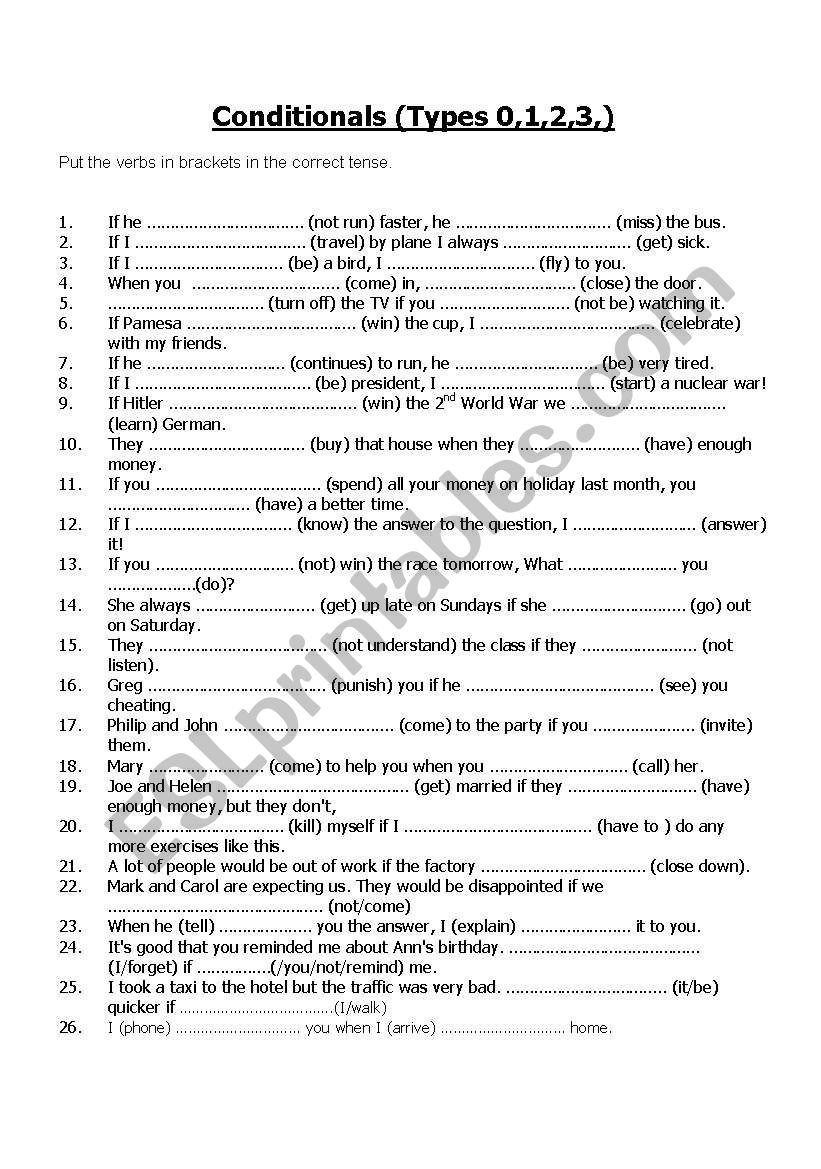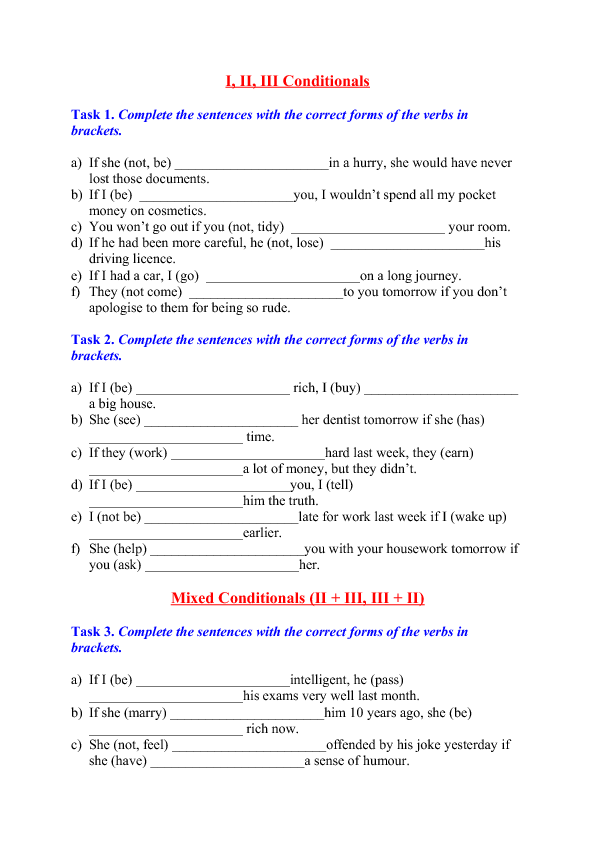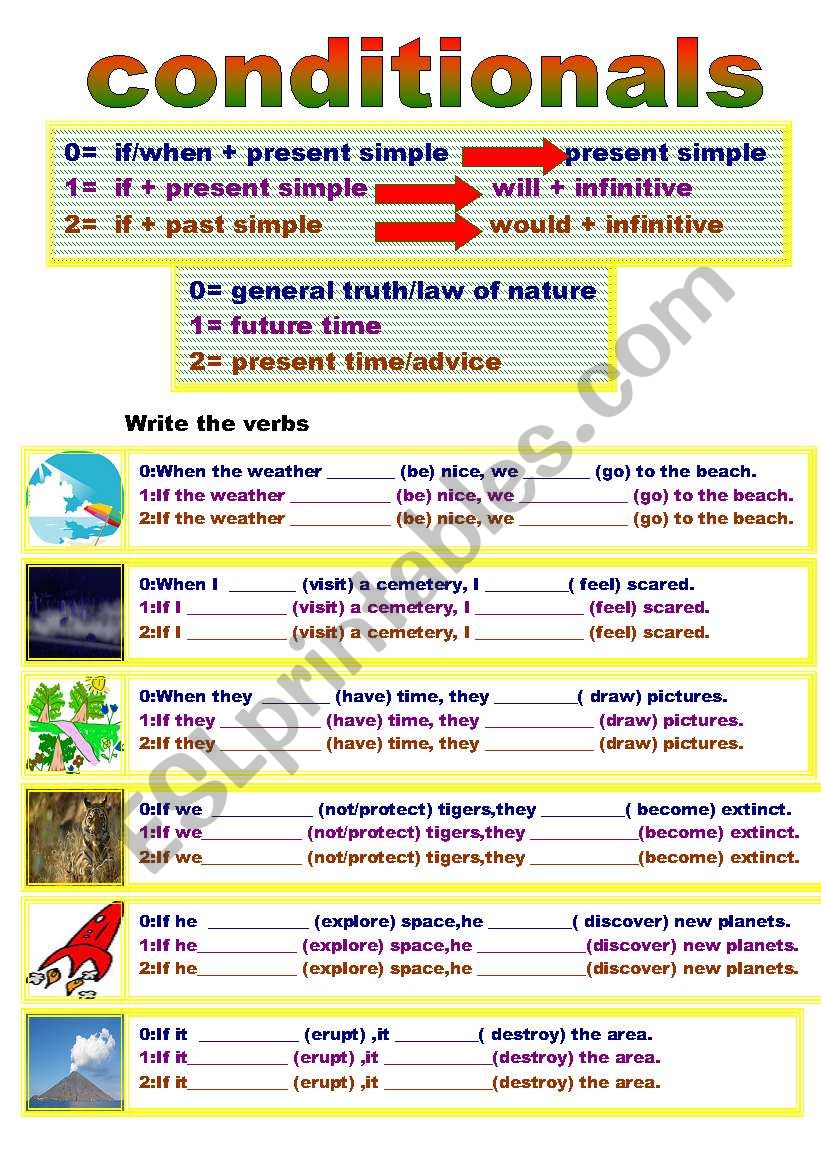
Mastering the Nuances of Possibility: A Deep Dive into Conditional Sentences Worksheets (0, 1, 2, 3, Mixed)
The English language, with its vast array of grammatical structures, often presents learners with both challenges and opportunities for expressive communication. Among its most versatile and frequently used constructions are conditional sentences. These powerful linguistic tools allow us to express possibilities, hypothetical situations, and their potential outcomes, ranging from scientific truths to speculative regrets. For language educators and self-learners alike, truly grasping the intricacies of conditionals requires consistent practice, and this is where well-designed Conditional sentences worksheets (0, 1, 2, 3, mixed) become indispensable.
This comprehensive article will explore the four main types of conditional sentences – Zero, First, Second, and Third – along with their sophisticated mixed variations. We will delve into their structures, common uses, and, most importantly, how Conditional sentences worksheets (0, 1, 2, 3, mixed) can be effectively utilized and created to solidify understanding and foster fluency.
The Foundation: Understanding Conditional Sentences

At their core, conditional sentences consist of two clauses: an "if" clause (the condition) and a main clause (the result). The relationship between these two clauses determines the type of conditional sentence. The choice of verb tense in each clause is critical for conveying the correct meaning regarding time and reality.

Type 0 Conditional: Facts and General Truths

The Zero Conditional is the simplest and most straightforward. It is used to talk about general truths, scientific facts, habits, and situations where a particular condition always leads to a specific result. The outcome is certain, not hypothetical.

- Structure: If + simple present, simple present.
- Examples:
- If you heat water to 100 degrees Celsius, it boils. (Scientific fact)
- If I eat too much sugar, I feel sick. (General truth/habit)
- If it rains, the grass gets wet. (Obvious consequence)



Designing Type 0 Conditional Sentences Worksheets:

Worksheets for Type 0 conditionals should focus on reinforcing the idea of certainty.
- Matching Exercises: Match the "if" clause with its inevitable "result" clause.
- Fill-in-the-Blanks: Provide the "if" clause (or main clause) and have learners complete the sentence with a verb in the simple present tense that logically follows.
- Sentence Completion: Give a prompt like "If you mix blue and yellow…" and students complete it.
- True/False Statements: Present conditional sentences and ask students to determine if they are factually correct.

Type 1 Conditional: Real Possibilities in the Future
The First Conditional is used to talk about real and possible situations in the future. The condition is likely to happen, and the result is a probable consequence.
- Structure: If + simple present, will + base form of the verb.
- Examples:
- If it rains tomorrow, we will stay at home. (Possible future situation)
- If she studies hard, she will pass the exam. (Probable outcome)
- If I find your keys, I will call you. (Likely action and consequence)
Designing Type 1 Conditional Sentences Worksheets:
Worksheets for Type 1 conditionals should encourage thinking about future plans, predictions, and consequences.
- Scenario-Based Prompts: Provide a scenario (e.g., "You win the lottery…") and ask students to write sentences about what they will do.
- Sentence Transformation: Convert simple sentences into Type 1 conditionals (e.g., "It might rain. We will cancel the picnic." -> "If it rains, we will cancel the picnic.")
- Question and Answer: Students ask and answer questions using Type 1 conditionals (e.g., "What will you do if you miss the bus?").
- Chain Stories: Start a conditional sentence and have students continue the story with subsequent Type 1 conditionals.
Type 2 Conditional: Unreal/Hypothetical Situations in the Present/Future
The Second Conditional is used for hypothetical or unlikely situations in the present or future. It describes something that is not true now, or something that is very unlikely to happen. It often expresses wishes, dreams, or advice.
- Structure: If + simple past, would + base form of the verb.
- Important Note: For the verb "to be" in the "if" clause, "were" is often used for all subjects (I, he, she, it, we, you, they) to emphasize the hypothetical nature, though "was" is also acceptable in informal speech for I/he/she/it.
- Examples:
- If I won the lottery, I would buy a big house. (Unlikely situation)
- If I were you, I would apologize. (Advice)
- If he spoke French, he would get the job. (He doesn’t speak French)
Designing Type 2 Conditional Sentences Worksheets:
Worksheets for Type 2 conditionals should spark imagination and critical thinking about alternative realities.
- Imaginary Scenarios: "If you could fly, where would you go?" or "If animals could talk, what would they say?"
- Advice Giving: Provide a problem and ask students to give advice using "If I were you…"
- Role-Playing: Students imagine themselves in different roles and discuss what they would do.
- Sentence Scramble: Unscramble words to form correct Type 2 conditional sentences.
- "What If" Questions: Open-ended questions that encourage creative responses.
Type 3 Conditional: Unreal Situations in the Past (Regrets and Missed Opportunities)
The Third Conditional is used to talk about hypothetical situations in the past. It describes something that did not happen and imagines the result if it had happened. It often expresses regret, criticism, or missed opportunities.
- Structure: If + past perfect, would have + past participle.
- Examples:
- If I had studied harder, I would have passed the exam. (I didn’t study, so I didn’t pass)
- If they had known about the traffic, they would have left earlier. (They didn’t know, so they were late)
- If she had taken the train, she wouldn’t have been stuck in traffic. (She didn’t take the train)
Designing Type 3 Conditional Sentences Worksheets:
Worksheets for Type 3 conditionals require a good grasp of past tenses and the ability to reflect on past events.
- Regret Statements: Provide a past negative event (e.g., "I overslept this morning.") and have students write a regret using Type 3 (e.g., "If I hadn’t overslept, I wouldn’t have been late for work.").
- Historical "What Ifs": "If the Titanic hadn’t hit an iceberg…"
- Error Correction: Present sentences with incorrect Type 3 structures for students to correct.
- Story Completion: Give the beginning of a story and have students imagine alternative endings using Type 3.
Mixed Conditionals: Blending Realities
Mixed conditionals combine elements from different conditional types, typically Type 3 and Type 2, or less commonly, Type 2 and Type 3. They are used when a condition in one time frame has a result in another time frame.
- Type 3 + Type 2 (Most Common): If + past perfect (past condition), would + base verb (present result).
- Use: A past action/situation affects the present outcome.
- Example: If I had studied harder (in the past), I would be a doctor now (in the present). (I didn’t study, so I’m not a doctor now.)
- Type 2 + Type 3 (Less Common): If + simple past (present/general condition), would have + past participle (past result).
- Use: A general truth or present hypothetical situation affects a past outcome.
- Example: If I were taller (a present hypothetical), I would have joined the basketball team (in the past). (I’m not taller, so I couldn’t join.)
Designing Mixed Conditional Sentences Worksheets:
Mixed conditional worksheets are for advanced learners and require careful construction.
- Sentence Combination: Provide two sentences from different timeframes and ask students to combine them into a mixed conditional.
- Contextual Scenarios: Present complex situations that require students to logically connect past actions to present results, or vice versa.
- Paragraph Writing: Ask students to write a short paragraph using mixed conditionals to describe a hypothetical situation.
- Error Analysis: Present sentences with common mixed conditional errors for students to identify and correct.
Crafting Effective Conditional Sentences Worksheets (0, 1, 2, 3, Mixed)
The true value of Conditional sentences worksheets (0, 1, 2, 3, mixed) lies in their design. A well-crafted worksheet moves beyond simple rote memorization and encourages deeper understanding and application.
- Clear Instructions: Ensure students know exactly what is expected of them for each exercise.
- Varied Exercise Types: Don’t just stick to fill-in-the-blanks. Incorporate:
- Matching: Connecting halves of sentences.
- Sentence Completion: Providing the correct verb forms.
- Sentence Transformation: Rewriting sentences using conditional structures.
- Error Correction: Identifying and fixing grammatical mistakes.
- Creative Writing Prompts: Encouraging students to produce their own conditional sentences in context.
- Discussion Prompts: Facilitating spoken practice.
- Contextualization: Present conditionals within realistic or relatable scenarios. This helps students see the practical application of the grammar. Instead of "If I (be) happy…", try "If my team (win) the championship, I (be) very happy."
- Gradual Progression: Start with simpler exercises for each type and gradually introduce more complex ones. When moving to mixed conditionals, ensure students have a solid grasp of the individual types.
- Focus on Meaning: Remind students that the choice of conditional type significantly changes the meaning of the sentence. Encourage them to think about the reality or unreality of the situation being described.
- Include Answer Keys: Essential for self-study and for teachers to quickly check work.
- Encourage Self-Correction: Design activities where students can identify their own mistakes, fostering a sense of autonomy in learning.
The Benefits of Using Conditional Sentences Worksheets
The consistent use of Conditional sentences worksheets (0, 1, 2, 3, mixed) offers numerous advantages for both learners and educators:
- Reinforcement: Repeated exposure to structures helps solidify understanding and recall.
- Targeted Practice: Worksheets allow learners to focus specifically on one grammatical area, addressing weaknesses.
- Identification of Gaps: Mistakes on worksheets can highlight specific areas where a learner needs more instruction or practice.
- Self-Paced Learning: Students can work through worksheets at their own speed, reviewing as needed.
- Assessment Tool: Teachers can use worksheets to gauge student comprehension and identify common errors across the class.
- Foundation for Fluency: Mastering conditional structures is a key step towards more complex and nuanced communication in English.
Conclusion
Conditional sentences are an undeniable cornerstone of fluent and accurate English communication. From stating universal truths to expressing profound regrets or imaginative possibilities, they enable a depth of expression that is vital for advanced learners. The journey to mastering these structures is significantly enhanced by well-designed and varied Conditional sentences worksheets (0, 1, 2, 3, mixed).
By systematically addressing each conditional type, from the straightforward Zero to the intricate Mixed conditionals, and by implementing diverse, contextualized exercises, educators can equip their students with the confidence and competence to wield these powerful linguistic tools effectively. Ultimately, the consistent practice afforded by these worksheets transforms a complex grammatical concept into an intuitive part of a learner’s English repertoire, paving the way for truly expressive and precise communication.
